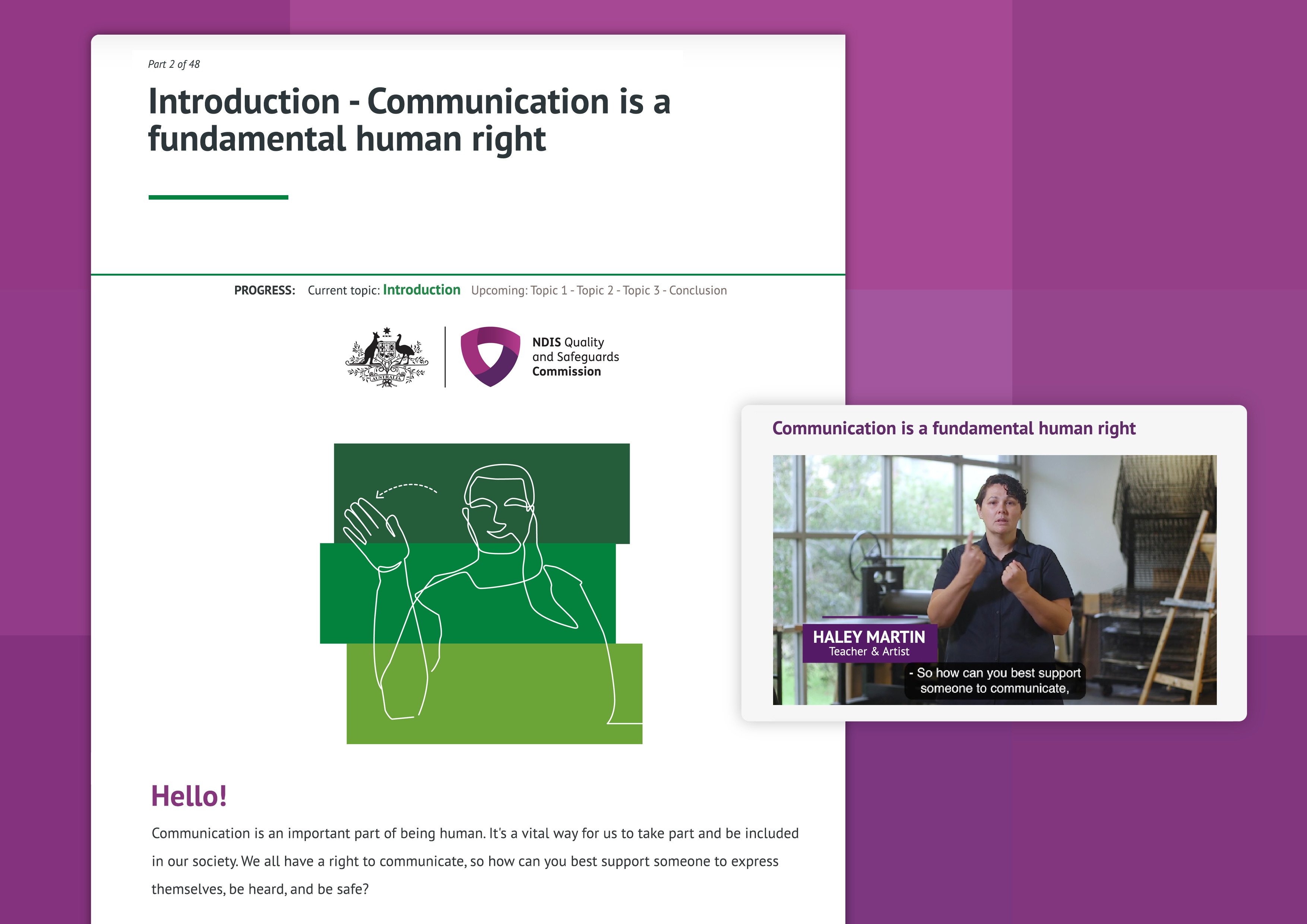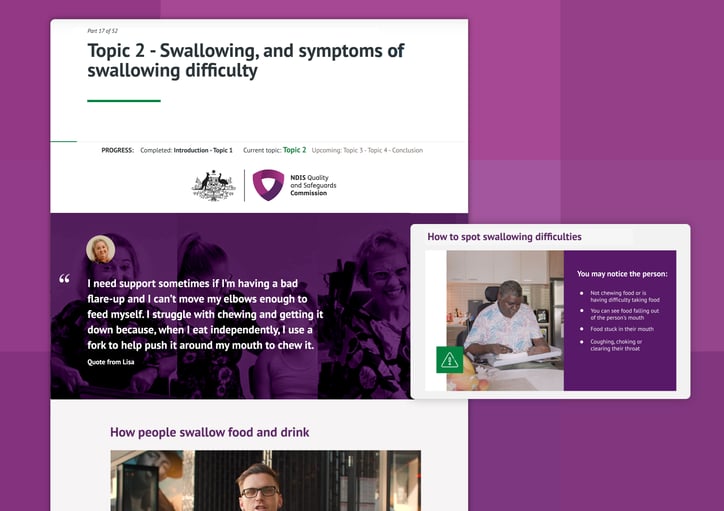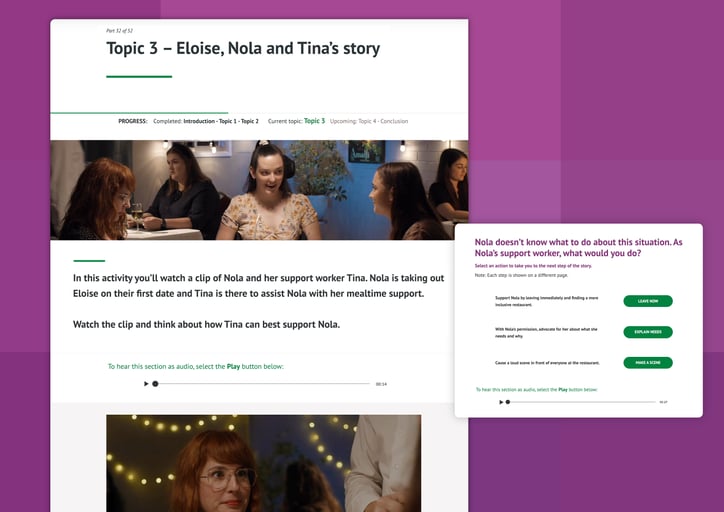When you work in eLearning, or any kind of content writing, someone will invariably say “You’ve worked on sooooooo many projects. You must know a lot by now!”
The uncomfortable truth is that the answer is “not as much as you’d think”.
When the next project comes along, most of what’s stored in your short-term memory is kicked out to make way for the new stuff.
And that’s okay. Unless you’re planning a career change, there’s little use in remembering the right PPE when starting at an underground metalliferous mine, or how to transfer patient records using the hospital’s new software, or the recommended storage temperature of avocados when you’re a wholesaler. (Yes, these are all real projects we’ve done.)
However, the most recent eLearning project I’ve worked on feels different. We were tasked by the NDIS Quality and Safeguards Commission to create two training modules on topics that address areas of risk to the wellbeing and safety of NDIS participants.
Personally, it feels like something that will go into my long-term memory. I hope it does.
“What did you learn?”
It’s the question you’re always asked in the review phase of a project. And I dread it every time.
Don’t get me wrong – it’s important. You want to have takeaways to help with future jobs. But the answers people want to hear tend to be about workplace processes and timelines: what worked, what didn’t, and what could be improved.
But, working in content, it’s hard to pull back to that level.
Case in point: the first module developed for the NDIS Commission looks at how to best support people with disability to communicate and express themselves. The second is about supporting people with swallowing difficulty to have safe and enjoyable meals.
Communication and meals are such fundamental parts of our lives. As someone who has never been exposed to high-risk challenges with either, there was a lot to learn.

Learning about the project
The first thing you learn are the whys.
Here’s the quick version: a 2020 report examining deaths of people with disability in Australia found that some cases could have been avoided. These modules introduce support workers to two key areas of risk and will be part of a broader response.
So, it's not light subject matter by any stretch of the imagination. These are complex topics, which affect different people with different needs in different ways. Providing effective support is a difficult balance of obligation, safety, advocacy, and care. But the content should be presented with a light touch – we need to support the supporters, not scare them away – educating those new to the disability sector and refreshing those with experience.
Fellow Liquidite Andrew Duval once said about eLearning “Everything we teach is meant to either save the world or improve it.” Hyperbole? You bet. The range between ‘improve’ and ‘save’ is huge. But, in this case, it feels justifiable.
Learning about the subject matter
The next stage is usually a content deep dive.
One of our jobs with content is to quickly get our heads around detailed and complex information and translate it into simple, useful, and engaging reading. Sounds easy when you say it quickly! That period where you plunge into those waters can be overwhelming and you have to come up for air often (to take the analogy to its logical end).
In this case, it was everything from augmentative and alternative communication (AAC) to the International Dysphagia Diet Standardisation Initiative (IDDSI) scale for food texture modification. From using only behaviours to communicate, to the visual signs of swallowing difficulty.
On this, the NDIS Commission have been great content guides throughout. It can be so easy to assume the knowledge that you have is universal – but they happily answered all our questions, no matter how basic (or how awkward we felt asking them).
Learning about the people
While you do learn a lot (and quickly), a content deep dive feels a bit like studying for an end-of-year exam half an hour after finding out you enrolled for the subject. And, if you’re not careful, that’s what the result can sound like – a mishmash of regurgitated facts.
Good content needs stories. Voices with expertise, experience, and empathy. It needs people.
Those stories come from our co-design group, who consisted of support workers, people with disability, their families, allied health workers, and representatives from advisory and community groups. Together, we strength-tested the structure, fine-tuned the facts, checked for representation, and heard stories of lived experience.
This approach isn’t unusual for Liquid, but the workshops we attended were informative in many ways. 30+ people with different communication styles all taking part on Zoom – they were masterclasses in positive modelling.

Learning it all again
Armed with all this knowledge, the time comes, of course, to apply it.
The combination of core content, expertise, and stories helped Liquid and Maitree House, our partners on this project, to write video scripts, activities, and scenarios to help give the content nuance and relevance, with humans at the centre.
As anyone who writes knows, this is where you really get stuck in the weeds craft – taking all that background and research and threading it into something that will inform, educate, and (sometimes) entertain. Draft, review, edit, repeat, repeat, repeat. Every word under the microscope, every scene checked for authenticity. While Liquid looked at structure, readability, design, illustration, and usability, Maitree looked at scripting, casting, filming, editing, and navigating people and places in the COVID world.
The great part was when we swapped our work and started to see it all come to life. I am in awe of everyone who appeared in front of and behind the camera, especially our presenters, actors, and ‘real voices’ interviewees – amazing disability advocates, one and all.
And then, suddenly, what’s been created is published and out into the wild. The two modules are available on the NDIS Commission website:
Learning about the learners
This article has all been written from a personal perspective, of course.
But the most important learning is always with the audience – what did they learn? While working out how successful training is can be difficult and only measured as part of a larger strategy, the responses we’ve been getting about the first module have been encouraging.
Here’s a sample:
- Thanks. This was one of the best ‘lived experience’ training I have seen in 30 years of my career! Well done!!
- I really enjoyed this module. It’s good to hear what the supported person really needs from us as support workers... opened my eyes.
- I would like to say that your learning modules are some of the best learning modules I have ever seen, and I am a trainer.
- Easy to understand – spoken by real people with different ranges of disabilities.
- The care and attention to detail provided by the creators of this training was evident throughout the production. Many thanks for a valuable training session!
- It is fabulous! I would highly recommend speech pathologists to watch it.
Phew.

“What did you learn?”
So… it’s time to pull back from all that detail and think about broad takeaways.
Hmmm. How about:
- Communication takes many forms. It’s straightforward but, for this project, it needed to be relearned. We encountered so many communication styles firsthand, it gave the way we delivered the learning so much relevance. Each ‘core’ module also has Australian Sign Language (Auslan), Audio-Described, and text-based ‘offline’ versions, each subtly different to accommodate that mode of communication.
- Having a voice is so important. Sometimes you learn important things in unexpected ways. While we were busy thanking our co-design group, many were thanking us. Why? For being included and heard. It was a real insight into the challenges at the heart of the communication module. It’s also a good reminder that for many projects, a blend of subject matter and lived experience expertise is essential.
- Learning means change (and that’s good). From the onset, we had planned to use Auslan only with the video content, and our exploration of similar online projects supported this. But discussions with Deaf Services taught us that translating video and written word is best practice, as some could find reading the content difficult. In short: Auslan isn’t English. When it’s put that simply it seems obvious, but it meant a big pivot in our approach.
- Having ‘the client’ as the presenter is a wonderful thing. The narrators for the learning and the performers in the scenarios were always to be people with disability. At a surface level, this could be just an effective way to illustrate to the learner some of the communication and swallowing difficulties covered, but it was more than that. eLearning works best when presented by an authority on the subject, or a knowledgeable peer. Our presenters are all that and more – they’re a reminder of why the modules exist (aka ‘the client’), they illustrate the goal of the learning, and they represented! It’s the change that you want to see and, going by the feedback, it’s been seen and appreciated.
While these takeaways still look through an eLearning prism rather than a project process / management / timeline one, they’re good answers to that key question. From a review perspective, anyway.
Retrospective, managed. 😊
